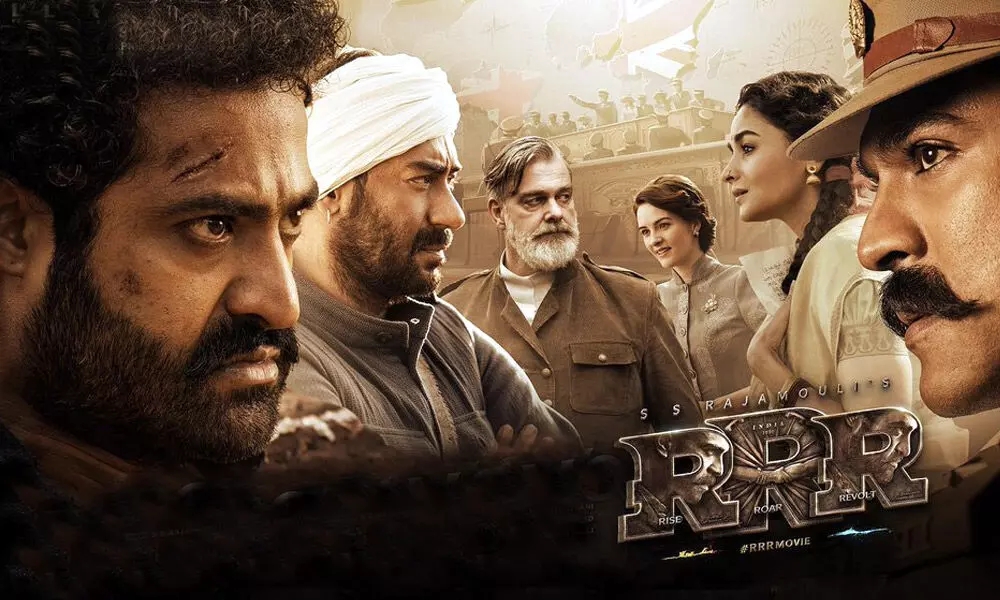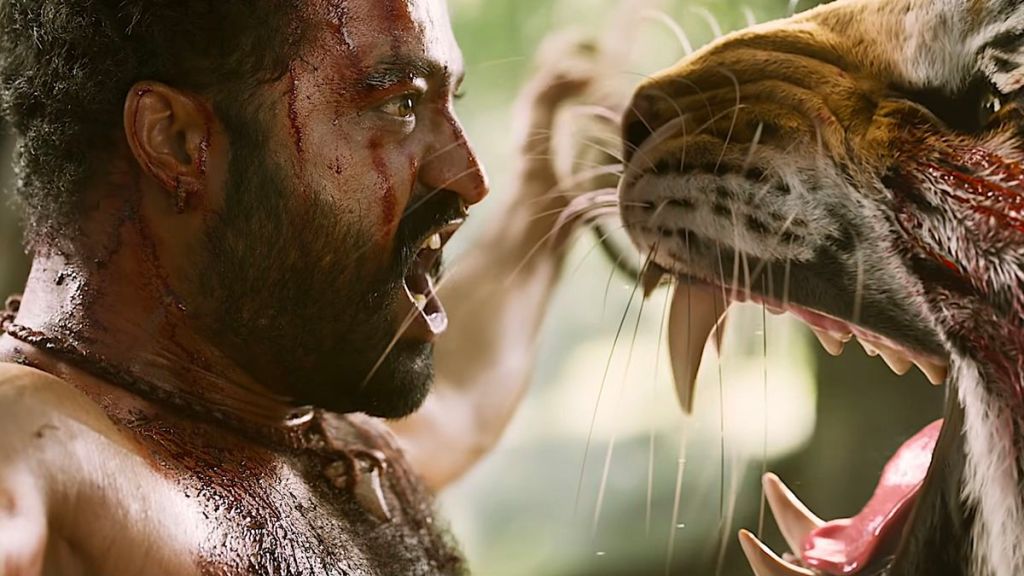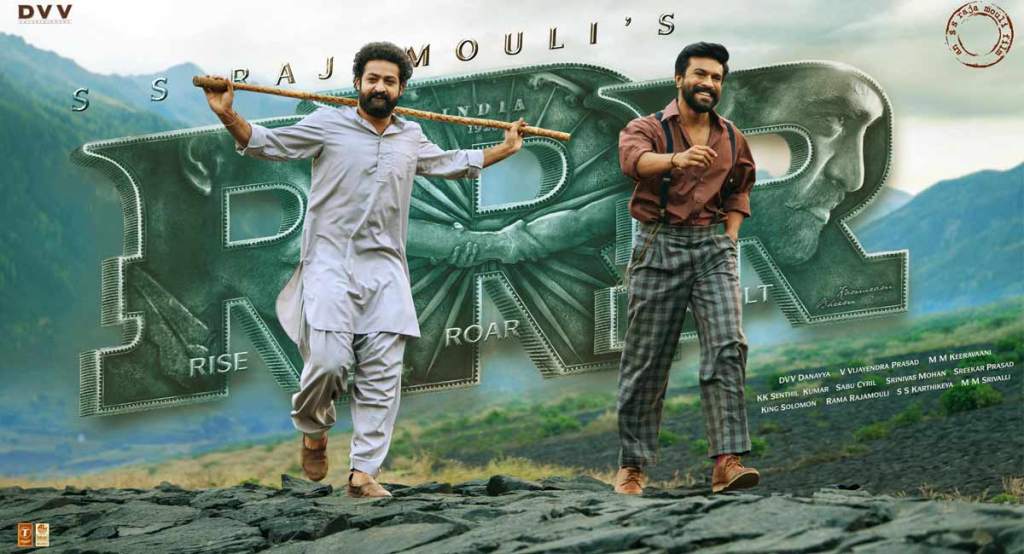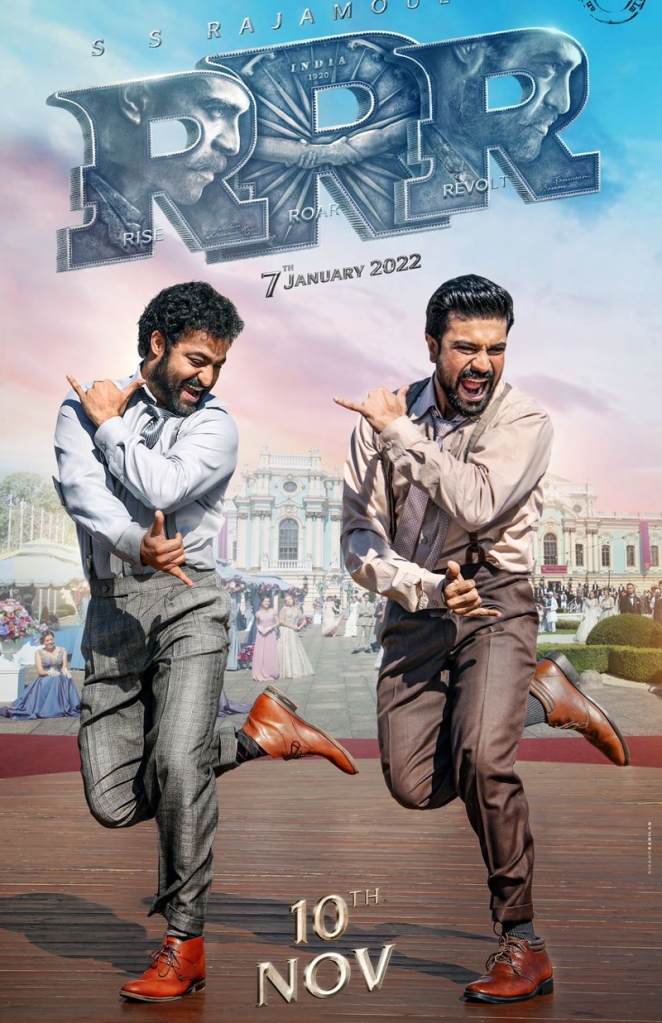Recently I’d been pondering exactly what I should do for the 300th article here on this blog. Should it be cheeky and pandering for fun? (a review of Zack Snyder’s 300 did cross my mind at one point) Should it be something to celebrate cinema as a whole? Or should I just breeze past the numbering without giving it much notice at all? Well, I was about to ignore the moment entirely but then I saw RRR, a historical action drama set in 1920’s India and I knew what I had to do. Plus, 3 R’s, 3 hours, 300th article- it just felt right.

Written by Vijayendra Prasad, S.S. Rajamouli, Sai Madhav Burra, Madhan Karky, and Riya Mukherjee, and directed by S.S. Rajamouli, “RRR (Rise Roar Revolt)” is a truly cinematic experience, one that I will remember for years to come. Set in 1920’s India while the country was still under British rule, the film begins with three scenes that lay the groundwork for the rest of the film. Using the three R structure, the first setup is “The Story” (with the R capitalized) which begins with the British Governor, Scott Buxton (Ray Stevenson) and his incredibly cruel wife Catherine Buxton (Alison Doody) visiting a Gond tribe village in the forests outside Delhi. Catherine takes an interest in Malli, the young girl singing and painting Mehndi designs on her hand. Thus, the Buxtons throw a few pence at the mother’s feet and leave with Malli in tow- much to the anguish of everyone in the village. The second scene, “The Fire” (Capitalized R here as well, you get the idea), introduces us to Alluri Sitarama Raju (Ram Charan), an Indian British Officer hell bent on proving his worth to his superiors. In this scene Raju, known better as Ram in the film, goes after a single protester out of an angry mob after breaking a picture with a thrown rock. Ram’s supervillain commitment to fighting through hundreds of people and enduring the crowd’s violent fervor just to drag one man back to the station was thrilling and an excellent way to introduce us to one of the major characters of the film. The third scene is titled “The Water” (Yes, the R was capitalized here too), in which we see the other force of nature in the film prove his own prowess as well. Komaram Bheem (N.T. Rama Rao Jr.), known in the film simply as Bheem, is the protector of the Gond peoples, and when one of them is missing, it causes all great strife. Bheem is essentially an avatar of the forest, or at least, that’s how he’s presented to us. Bheem’s opener begins with him attempting to capture a wolf, but is thrown off his course by an intervening Tiger instead which immediately causes this jungle chase scene to ramp up in tenacity and intensity. Luckily Bheem can tango with the tiger and afterwards we get some dialogue where Bheem and his rescue party wonder if Malli is even still alive after six months of preparation. Then, the title card drops and the movie really begins. This is about forty minutes into the movie.

It isn’t long before the British hear rumor of a Gond village protector who intends to retrieve Malli and return her to the forest and her people. The unruffled British authorities don’t seem to mind much, what’s one man before an Empire? They’re eventually persuaded by an advisor who knows of Bheem’s reputation, and after laying out that goal, catch this unknown insurgent, Ram immediately steps up to the plate and takes on that order with precision and tenacity. Thus we have our two main characters set on opposite sides of the law, how much more inherent drama could you soak out of that potential? As it turns out, quite a lot! After Ram loses the one lead he has in Delhi early on, he and Bheem almost lose faith in their causes at the same time. However, a train on a bridge explodes and puts a child in the river below at risk which results in one of the most memorable action set pieces of the first half of the film. Both Ram and Bheem eye each other from across the river as each can see the other organizing the fearful people around them and both leap into action. Ram on a horse, Bheem on a motorcycle, both race atop the bridge with a rope at each end, jump off at full speed, swing through the fire below and save the kid from certain death. This kickstarts a montage of Ram and Bheem becoming the best of friends after saving that kid. It’s almost like a music video devoted to friendship, and I can not lie, I was cackling in the theater. It was at this point when I said to myself, “I think I love this movie”.

After seeing the whole thing, I can attest to my love of this film. I won’t dive too much further into plot points though, as I feel these revelations are best discovered within the film itself. What I can say about the film as a whole is that the best aspects of the film are in it’s energy, the drastic tonal shifts that are handled with care, and the character work between both Ram and Bheem. Due to the film’s use of familiar story beats and easy to predict plot developments, I was initially curious as to what the film could do to surprise modern audiences. Well, surprise it did. I may have seen the broader story beats coming from a mile away, but I certainly didn’t expect the song and dance numbers scattered throughout the film, and the wild tenacity of the characters. Even though I could guess a couple of the evolutions, it didn’t lessen my experience at all. In fact I was continually aghast at the sincere and earnest nature of the writing and acting performances (which are also outstanding), as Bheem and Ram go through some serious character arcs and evolution throughout the film. I also found the balancing act between the joyous dance numbers like “Naatu Naatu” and the highly emotional song Bheem sings while being whipped with a watching crowd to be cinematic perfection. The duality of storytelling is on display here, it’s all very tongue in cheek at times and the film knows how ridiculous it is, but it also knows how to pull at your emotions with extreme vigor too.

“RRR” is a tale of revolutionaries fighting against an empire, but it’s also a love story. It’s a tale of redemption. A story of betrayal. It’s a War film, and it’s also a string of character-fueled dance numbers full of heart. This film was truly an experience, and I highly recommend seeing it if it’s showing in your area. Granted, it’s a long one, and the ticket prices for this one are generally double per seat, but I found it to be money well spent. I went to be entertained, to see international cinema, and to be told a story. I got what I wanted (and more!), and hopefully you’ll find it to be just as worthwhile as I did.
Final Score: 1 English Bullet